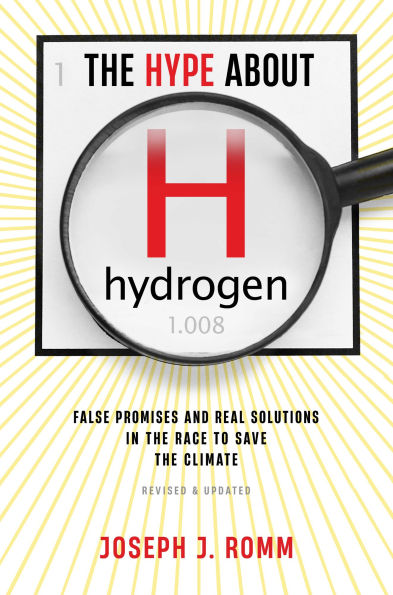Home
the Hype About Hydrogen, Revised Edition: False Promises and Real Solutions Race to Save Climate
Barnes and Noble
Loading Inventory...
the Hype About Hydrogen, Revised Edition: False Promises and Real Solutions Race to Save Climate in Franklin, TN
Current price: $35.00

Barnes and Noble
the Hype About Hydrogen, Revised Edition: False Promises and Real Solutions Race to Save Climate in Franklin, TN
Current price: $35.00
Loading Inventory...
Size: Paperback
For decades, we’ve been promised that a hydrogen economy is just around the corner: a high-tech Eden in which our cars, homes, and industries would be powered not by fossil fuels but by hydrogen from pollution-free sources. After billions in investment, hydrogen has failed to live up to these overblown promises. Yet it is as hyped as ever, a target of media enthusiasm and hefty investment from government and industry. Is it time to accept that the "fuel of the future" may never arrive?
In 2003, energy expert Joesph J. Romm wrote
The Hype About Hydrogen
to explain why hydrogen wasn’t the panacea we were promisedand may never be. In this newly revised and updated edition, Romm builds an even stronger case, explaining the barriers hydrogen faces, from its inefficiency as an energy carrier to the “chicken-and-egg” problem in infrastructure development and the risk of increased global warming from hydrogen leaks and emissions. In a series of significant updates, Romm breaks down the latest methods of production, including "green" hydrogen, hydrogen made with nuclear power, geologic hydrogen, and “blue” hydrogen from natural gas with carbon capture and storage (CCS), laying out the challenges with each. He then explores the limitations of suggested applications of hydrogen, including e-fuels made with direct air capture of CO2, hydrogen cars, and heating in buildings and industry.
is essential reading for anyone who hopes that hydrogen will be a major solution to the climate crisis. The good news? We don’t need it to be. With advancements in renewables and battery technology, electrification offers us a path forward that is cleaner, saferand can be implemented today.
In 2003, energy expert Joesph J. Romm wrote
The Hype About Hydrogen
to explain why hydrogen wasn’t the panacea we were promisedand may never be. In this newly revised and updated edition, Romm builds an even stronger case, explaining the barriers hydrogen faces, from its inefficiency as an energy carrier to the “chicken-and-egg” problem in infrastructure development and the risk of increased global warming from hydrogen leaks and emissions. In a series of significant updates, Romm breaks down the latest methods of production, including "green" hydrogen, hydrogen made with nuclear power, geologic hydrogen, and “blue” hydrogen from natural gas with carbon capture and storage (CCS), laying out the challenges with each. He then explores the limitations of suggested applications of hydrogen, including e-fuels made with direct air capture of CO2, hydrogen cars, and heating in buildings and industry.
is essential reading for anyone who hopes that hydrogen will be a major solution to the climate crisis. The good news? We don’t need it to be. With advancements in renewables and battery technology, electrification offers us a path forward that is cleaner, saferand can be implemented today.
For decades, we’ve been promised that a hydrogen economy is just around the corner: a high-tech Eden in which our cars, homes, and industries would be powered not by fossil fuels but by hydrogen from pollution-free sources. After billions in investment, hydrogen has failed to live up to these overblown promises. Yet it is as hyped as ever, a target of media enthusiasm and hefty investment from government and industry. Is it time to accept that the "fuel of the future" may never arrive?
In 2003, energy expert Joesph J. Romm wrote
The Hype About Hydrogen
to explain why hydrogen wasn’t the panacea we were promisedand may never be. In this newly revised and updated edition, Romm builds an even stronger case, explaining the barriers hydrogen faces, from its inefficiency as an energy carrier to the “chicken-and-egg” problem in infrastructure development and the risk of increased global warming from hydrogen leaks and emissions. In a series of significant updates, Romm breaks down the latest methods of production, including "green" hydrogen, hydrogen made with nuclear power, geologic hydrogen, and “blue” hydrogen from natural gas with carbon capture and storage (CCS), laying out the challenges with each. He then explores the limitations of suggested applications of hydrogen, including e-fuels made with direct air capture of CO2, hydrogen cars, and heating in buildings and industry.
is essential reading for anyone who hopes that hydrogen will be a major solution to the climate crisis. The good news? We don’t need it to be. With advancements in renewables and battery technology, electrification offers us a path forward that is cleaner, saferand can be implemented today.
In 2003, energy expert Joesph J. Romm wrote
The Hype About Hydrogen
to explain why hydrogen wasn’t the panacea we were promisedand may never be. In this newly revised and updated edition, Romm builds an even stronger case, explaining the barriers hydrogen faces, from its inefficiency as an energy carrier to the “chicken-and-egg” problem in infrastructure development and the risk of increased global warming from hydrogen leaks and emissions. In a series of significant updates, Romm breaks down the latest methods of production, including "green" hydrogen, hydrogen made with nuclear power, geologic hydrogen, and “blue” hydrogen from natural gas with carbon capture and storage (CCS), laying out the challenges with each. He then explores the limitations of suggested applications of hydrogen, including e-fuels made with direct air capture of CO2, hydrogen cars, and heating in buildings and industry.
is essential reading for anyone who hopes that hydrogen will be a major solution to the climate crisis. The good news? We don’t need it to be. With advancements in renewables and battery technology, electrification offers us a path forward that is cleaner, saferand can be implemented today.

















